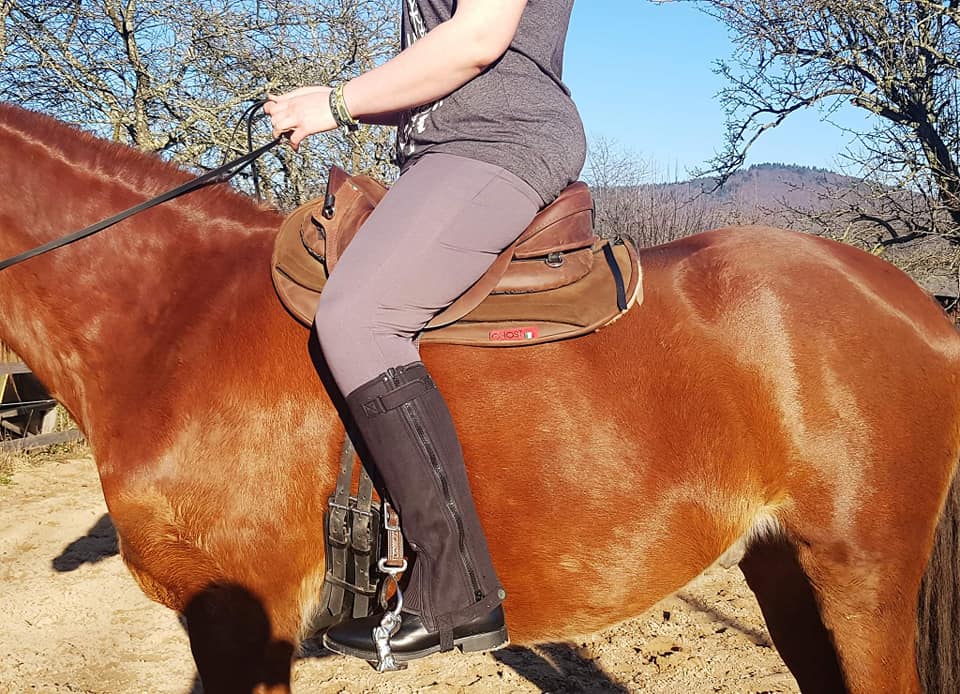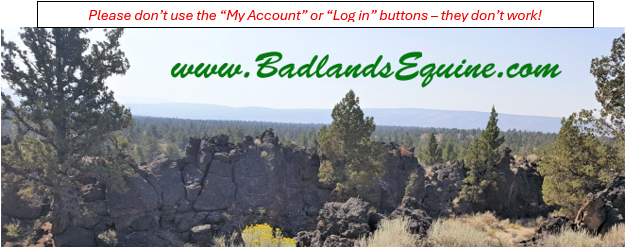by Rider Size
The Ghost saddle is not designed to the typical American/British units of inches. They use cm in Italy, plus the seat sizes are really labeled Standard, Piccolo, and Bambino.
I use inches on my site because that's more commonly used in the US. The Piccolo is very close to a typical 17" seat, with the straight blocks feeling a little smaller. The Bambino is very close to 16", maybe a touch larger. The Standard is closer to 18.25" so will feel large for someone who wants a 17.5".
To accomodate in-between sizes, we have seat reducers. Ghost makes a cushy one that velcros under the seat at the cantle and it reduces the seat by roughly 3/4". I also carry spacers I make from wool felt. They are 1/4" layers and can be used up to 3 to reduce seat size in 1/4" increments. This is great for kids who will grow over time or riders whose weight fluctuates throughout the year or riders who share a saddle. A higher cantle may reduce the feel of seat size by 1/8".
My seat sizes are based upon english seats, if you're coming from a western saddle, subtract 2".
With the advent of new models, there is some variation in seat feel compared to the size label. Here's a quick reference specifically for those of you looking for in-between sizes, based on choosing 17"/piccolo:
| Model name | Feels like |
| Buttera | 16.5" |
| Puro Plus | 16.5" |
| Quilty/Roma | 16.8" |
| Quevis/Veneto | 17" |
| Torino/Ferrara | 17.5" |
This table is purely from the perspective of the room available for your thigh behind the thigh block. It is still best to choose a model based upon the angle between your torso and thigh. If you have a longer thigh, the angled blocks can work better unless you ride with a really straight leg. In general, you want your seat bones on the seat (not the cantle) and the front of the thigh behind the block, not on top of it. There is more room for the thigh with the models without blocks or the Torino and Ferarra.If you're unsure what size to go with, email me and we can look at pics or discuss measurements. The thigh blocks are a limiting factor, so a thigh circumference measurement can be helpful. Measure the upper, fullest part of the thigh when standing, this will correspond to the available space from the cantle to the top of the thigh block. In general, Ghost is fairly conservative regarding rider weights and considers it a seller responsibility to ensure horse welfare to the extent possible. The latest base and panels do an excellent job of ensuring spine clearance for riders up to 200 pounds, but I think this is the high limit and rider balance and activity should be considered before choosing treeless. A balanced rider doing casual trail rides, particularly on a gaited horse, will distribute weight more evenly than an inexperienced rider trotting in 2-point or posting all day for an endurance ride. I consider 185 pounds to be the high for endurance riders, preferably 175 or under. We dealers may not sell a saddle to all riders if we don't think the saddle can do a sufficient job distributing weight to keep psi under a level which could cause white hairs from excessive pressure.
We also have a new Mini saddle for young children. It looks like a Quevis/Quilty but is on a Bareback Pad base with included pad. The seat is 3" smaller than the bamini (16").
Thigh circumference | Model |
22 or less | 17" Puro+ or Buttera |
23 or less | 17" Roma/Quilty |
24 or less | 17" Veneto/Quevis |
25 or less | 17" Torino/Ferrara |
25-29 | 18" Roma/Quilty |
26-30 | 18" Veneto/Quevis |
31 or less | 18" Torino/Ferrara |
The adjustable block models have a lot more room for error. Otherwise, the seats are the same from model to model. You might see pics that indicate one model has a deeper seat, but either that saddle has been ridden in on a horse with a curvier back or seat reducers and pommel bolsters are in place which make the seat deeper. If you have a very flat backed horse, the saddle will likely feel like the seat is less deep, but the pommel bolster can help as well as narrowing the twist even further.
Please don't try to go with a smaller seat because your horse has a short back. If you need the 18" seat, go with it because if your seat bones are on the cantle, which isn't designed to carry weight, you won't be distributing weight evenly. And the flexible nature of a Ghost means that the front and rear couple inches of the panels aren't fully weight bearing so are unlikely to cause an issue with most horses. Likewise, going with a too small seat means that the back part of the panel won't have sufficient weight and can float over the horse's loins, causing hair scrubbing.
| This rider is too large for this saddle, putting weight on the cantle. The cantle isn't designed to support weight and the base won't properly follow the shape of the horse's back with weight here. |  |
As mentioned above, Ghost is generally conservative on rider weight out of concern for the horse. There have been significant changes to the design of the base and the rigidity and ability to distribute weight with the panels. There are two things a saddle must do - protect the horse's spine and distribute weight over as large an area as possible. At a minimum, the saddle must keep the spine free from pressure, but it should also enable airflow along the spine for long hot rides. Sometimes the saddle can accomplish this alone, sometimes a pad is needed to contribute additionally. There are many pads that make the situation worse, so keep this in mind when pairing a pad and saddle to you, your horse, and riding activities.
Regarding weight distribution, I do get many inquiries from heavier riders who've gotten conflicting information: riders should be under 160lbs for treeless vs riders doing Tevis on treeless saddles who weigh 230 or more. It does depend on the saddle to begin with. If you can fold the saddle in half at the area your seat bones would rest, I would advise to avoid that saddle for anyone, but particularly heavier riders. There have been many improvements with several treeless brands, Ghost included, just within the past 3 years. My current advice is 175 or under for endurance riders, particularly those posting or 2-pointing for hours, and 200 or under for casual riders. There is room for some variation with rider skill, riding activity, gaited vs non-gaited (a sitting rider is spreading weight over a bigger area than one 2-pointing), the condition of the horse's back. I wouldn't advise using treeless with a heavy rider to recover a back with hollows or with a prominent spine either conformationally or because of muscle loss or being under weight.
Here is the math that can be used for any saddle. Figure out the contact area of the saddle with your weight in it. This is a rough estimate for Ghost, but using the panels for the Standard or 18" seat, and accounting for the fact that a treeless saddle will never be totally weight bearing along the entire length or width of the panels, I estimate 4.5" x 18" of contact area which is 81 square inches per side for a total of 162 square inches. If we take a rider of 220lbs and calculate psi (pounds per square inch), the result is around 1.4psi. The rule of thumb I use is that any constant pressure of 1.5psi will prevent blood flow into the skin and hair follicles, thus creating the possibility of white hairs. 1.4 is pretty close to 1.5 and there is likely to be higher pressure in the middle of the saddle since it's flexible (same thing happens with flex tree saddles and even with a treed saddle, pressure is higher at the front if the rider is in 2-point or during the rising phase of posting, it's just the nature of combining a moving animal and a shifting rider center of gravity). For this reason, I don't advise riders over 200 to jump into Ghost lightly. For riders slightly over, I would want to talk about riding skill/balance, riding activity, and see pictures of the horse's back and then discuss any methods of evaluating success beyond the usual monitoring of horse attitude, way of going, and reaction to palpation.
Updated seat size info! Since we have some new models with different styling, there are some additional seat size considerations. The Buttera feels about 1/2" smaller, so if you normally ride a 17" Ghost, consider doing an 18" Buttera or Buttera Maxxi. The blocks of the Ferrara and Torino give a bit more room to the seat so feel almost 1/2" bigger. I normally ride a 17" (although sometimes with seat reducers) and feel best in a 16" Torino. Things to think about for those in between riders too!
